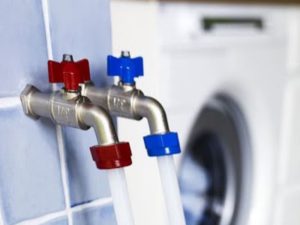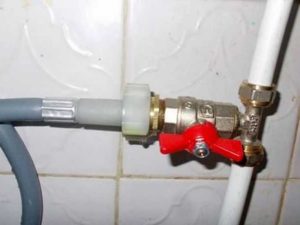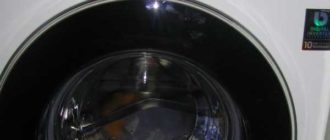 Many people know that the washing machine consumes a large amount of electricity for heating water, so in an attempt to save money, you may wonder: how to connect the washing machine directly to the hot water supply? How significant the energy savings will be and whether it will not harm the washing machine? Let's find out.
Many people know that the washing machine consumes a large amount of electricity for heating water, so in an attempt to save money, you may wonder: how to connect the washing machine directly to the hot water supply? How significant the energy savings will be and whether it will not harm the washing machine? Let's find out.
Why is it so important to look at the manual? First of all, it is worth looking at the manual, if your machine is very old, it is possible that it has two fill hoses for cold and hot water, respectively ,
...and for some modes, such machines would take hot water, but still mix it with cold water and heat as needed.
The bottom line
But over time this idea was abandoned, perhaps for the sake of economy and simplicity of the washing machines themselves. So now most washing machines are designed to connect only to cold water, and when you connect to hot water, you may encounter some problematic areas.
Read more at .
Possible problems when you connect your washing machine to hot water
These washing machines are designed to connect only to cold water are so that heated cold water to the correct temperature in accordance with the mode that you have selected and when the tank is filled with hot water temperature around 60C, many machines perceive it as an emergency situation, they say some of the heating elements in the machine is out of order and too overheated water. Then the washing machine will simply stop working and will give an error.
The second, no less important problem is that hot water is considered technical water and therefore is not treated as thoroughly as cold water. It often contains impurities, and if your house is heated boiler room, then in the hot water is often added even caustic soda to reduce the scale at the boilers in the boiler room. It's also possible that various small debris can get into the machine as well. In such untreated to sterile water, the powder dissolves poorly, and various bio-additives become especially useless to improve the quality of washing.
Important to know: This problem can be solved by buying a filter, but quite expensive, because you will need a fine filter for different impurities in the water.
The third problem is the filling hose. Most often it is made of plastic or similar materials that are not designed for high temperatures, which means that you will have to change it often and watch out for leaks.
The fourth problem and the most important, washing machines, designed to connect only to cold water, do not know how to cool water. The temperature of hot water is always around 60C, and washing at 20, 30 and 40 degrees is not possible. Will it affect the quality of washing? Definitely.
It is important to know:
 And yet now you can find a modern washing machine with two fill hoses for hot and cold water.
And yet now you can find a modern washing machine with two fill hoses for hot and cold water.
The source of the hot water supply in your home. What kind of water goes into your washing machine.
If the previous cons haven't dissuaded you from connecting your washer to hot water, it's also worth talking about where the hot water gets into your machine.
There are two ways to deliver hot water to the consumer. The first is through the centralized networks of DHW, such water will always be no lower than 50C and no more than 70C, which will push you to all those problems that have been described above. In addition, how to be, if in the summer will be cut off hot water for repairs? To reconnect the washing machine?
But here is the second way, it is if your apartment or house is a local water heater, such as a boiler with a boiler or a gas boiler. In this case the water is served to you only cold and heated by the local heater, and therefore its quality remains at the level of drinking, rather than technical. But most importantly, you yourself can regulate the temperature of hot water in the process of washing. That is, you will have to take on the role of automatics, if usually washing machines heat the water themselves, then you will have to cool it yourself.
Figuring out the washing process
In this case, it is worth separately understand what is the washing process in terms of temperature mode.
In the beginning, the fabric is soaked in cold water and here you will need to lower the temperature. Then, when the main washing process will go, increase the water temperature to your chosen mode, but the rinse again is better to do in cold water, so it is better to remove the remains of the powder.
If you have accepted all the minuses, then here is a small instruction on how to connect the washing machine yourself.
You will need:
- Fluoroplate sealing material.
 - adjustable wrench.
- adjustable wrench.
- ¾-inch silicone or rubber grommets
- two ¾" tee valves with a side outlet.
- ¾" adapters, also ¾
- and flow filters, also ¾".
Before installation, it is necessary to screw the filters to the tees to eliminate the risk of contamination of the washing machine with dirt from the pipeline.
Then shut off both hot and cold water risers.
Under the faucet, find the junction area between the main pipe and the hoses that go to the faucet. Disconnect them.
On both pipes screw tees, here you can use adapters, they should come with.
Then screw the hoses from the faucets to the tees, then add and intake, for this use fluoroplate sealing material.
Now connect the water and the washing machine. But it is important that all connections are tight and there are no leaks. Carefully check everything!
Important: If you can not connect the washing machine yourself, it is better to use the services of a master.
Unsatisfactory conclusions
What do we have as a result? It is possible to connect the washing machine to hot water, but the quality of washing will inevitably deteriorate, in addition, you will have to constantly check the condition of the machine. Will you save on electricity? Only if you have a local water heater, because the price for hot water can also be high, but then you have to manage the washing process for the automatics. Whether the savings are worth the effort is up to you to decide of course.





Capitalism is the thing when you do not do what people need, and what you need, but convince them that this is exactly what they wanted. It's the same here. The only reason, simplification of design. The manufacturer doesn't need to solve your money-saving problems. He needs to sell you a nice piece of junk at a maximum price with a minimum of cost. For example, the excuse of improper washing due to the content in the hot water caustic soda in general fairy tale. In the days of our mothers and grandmothers washed with it. That's just washing with it, because it is a terrible alkali. And all detergents have an alkaline reaction. And you can also use it to clean clogged pipes, clean burnt dishes, wash off old paint, remove stubborn grease from ceramic tiles, clean tiles in the kitchen, and much more. But it's too cheap and simple. And here you are sold all sorts of calgons, anti grease, moles and supercleaners . Same eggs but from the side. About water purification, too, the song. You do not need fine filters for laundry. In cold water impurities no less than in hot water. In terms of equipment protection, hot water is even preferable, as it has additives against corrosion and scaling. Phosphates and soda. I've already written about baking soda. Phosphates are in laundry detergents. And Coca Cola has accustomed people to the taste of orthophosphoric acid solution. And they don't die. So it's all excuses from the manufacturers. It really is easier for them to heat cold water for the desired mode of washing, than to program the brain to mix cold and hot.